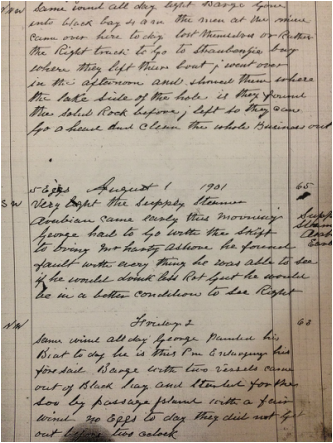Place has always played an inspirational role in my writing. The geography, climate, people, history and cultures inherent to northwestern Ontario have influenced my work, weaving themselves into my stories. Having spent a significant portion of my childhood on and around Lake Superior, it is not surprising that this magnificent body of water became part of the setting for The Lightkeeper’s Daughters.
I grew up sailing. From early childhood, my weekends and summer holidays were spent aboard our family’s sailboat, cruising the north shore of Lake Superior, visiting places like Silver Islet, Porphyry Island, Loon Harbour, Otter Cove and Isle Royale. In spite of the magnificent beauty of the Lake, the cold temperatures and isolation meant that anchorages were rarely crowded, and there was plenty of opportunity to observe wildlife and experience the majesty and solitude of the environment.
Considered to be the largest freshwater lake in the world, in reality, Superior is more like a sea. It has almost 3000 km of shoreline, an average depth of 489 feet (150 meters or 81.5 fathoms) and temperatures that hover around 4 degrees Celsius (40 F). Fog is common in spring and summer. October and November breed the infamous storms that have claimed more than one ship. Superior is cold and vast and temperamental. And stunningly beautiful.
As my story evolved, the Lake emerged as a character in its own right. Not only did it provide the setting – a setting that was dynamic and evolving in itself – it affected and changed the lives of the characters whose stories were being lived out on the pages. It was integral to the story. It was important to me, as a writer, that the reader viscerally experiences the setting, seeing it, hearing it, tasting it, feeling it – experiencing it. And eventually, the Lake took an active role in shaping the lives of the Lightkeeper’s Daughters.
Here are a few ways to consider using setting as character:
I grew up sailing. From early childhood, my weekends and summer holidays were spent aboard our family’s sailboat, cruising the north shore of Lake Superior, visiting places like Silver Islet, Porphyry Island, Loon Harbour, Otter Cove and Isle Royale. In spite of the magnificent beauty of the Lake, the cold temperatures and isolation meant that anchorages were rarely crowded, and there was plenty of opportunity to observe wildlife and experience the majesty and solitude of the environment.
Considered to be the largest freshwater lake in the world, in reality, Superior is more like a sea. It has almost 3000 km of shoreline, an average depth of 489 feet (150 meters or 81.5 fathoms) and temperatures that hover around 4 degrees Celsius (40 F). Fog is common in spring and summer. October and November breed the infamous storms that have claimed more than one ship. Superior is cold and vast and temperamental. And stunningly beautiful.
As my story evolved, the Lake emerged as a character in its own right. Not only did it provide the setting – a setting that was dynamic and evolving in itself – it affected and changed the lives of the characters whose stories were being lived out on the pages. It was integral to the story. It was important to me, as a writer, that the reader viscerally experiences the setting, seeing it, hearing it, tasting it, feeling it – experiencing it. And eventually, the Lake took an active role in shaping the lives of the Lightkeeper’s Daughters.
Here are a few ways to consider using setting as character:
- Make your setting inherent to the story. Would it be the same if it were set someplace else? What unique qualities of the setting can be employed to enhance the storytelling?
- Engage all of your reader’s senses, allow them to see, feel, hear, taste – experience the setting. When they close the book, do they feel like they’ve been there?
- Keep the setting dynamic. A static setting is a backdrop. An evolving setting that possesses moods, that reacts and changes, becomes living.
- Have your setting interact with the characters. How do they develop through their interaction with the setting? Does the setting challenge them? comfort them? antagonize them? It’s important to see the setting through the character’s eyes. It is how the character views the setting that will make it unique.
- Use the setting to create emotion, mood, atmosphere.
- Allow the setting to directly influence the plot. What role can it play in changing the course of events?
| We were on the beach, the black volcanic sand warm beneath our bare feet. The Lake was calm and chatted quietly as it breathed between the rocks. Emily was there, but it could have been just the two of us; he with his violin and me braiding the purple beach pea flowers into a garland for my hair. He was standing on the point, his brown hair tousled by the wind, his canvas pants rolled to the knees, fiddling like an ancient Greek Siren, drawing not sailors but the young lightkeeper’s daughter under his spell. It was a tune I hadn’t heard before. Sweet, airy. The song was captured by the trees, filtered by the sand and shared with the waves, but I didn’t mind. My pulse quickened with every phrase. - except from The Lightkeeper's Daughters (HarperCollins 2017) |


 RSS Feed
RSS Feed